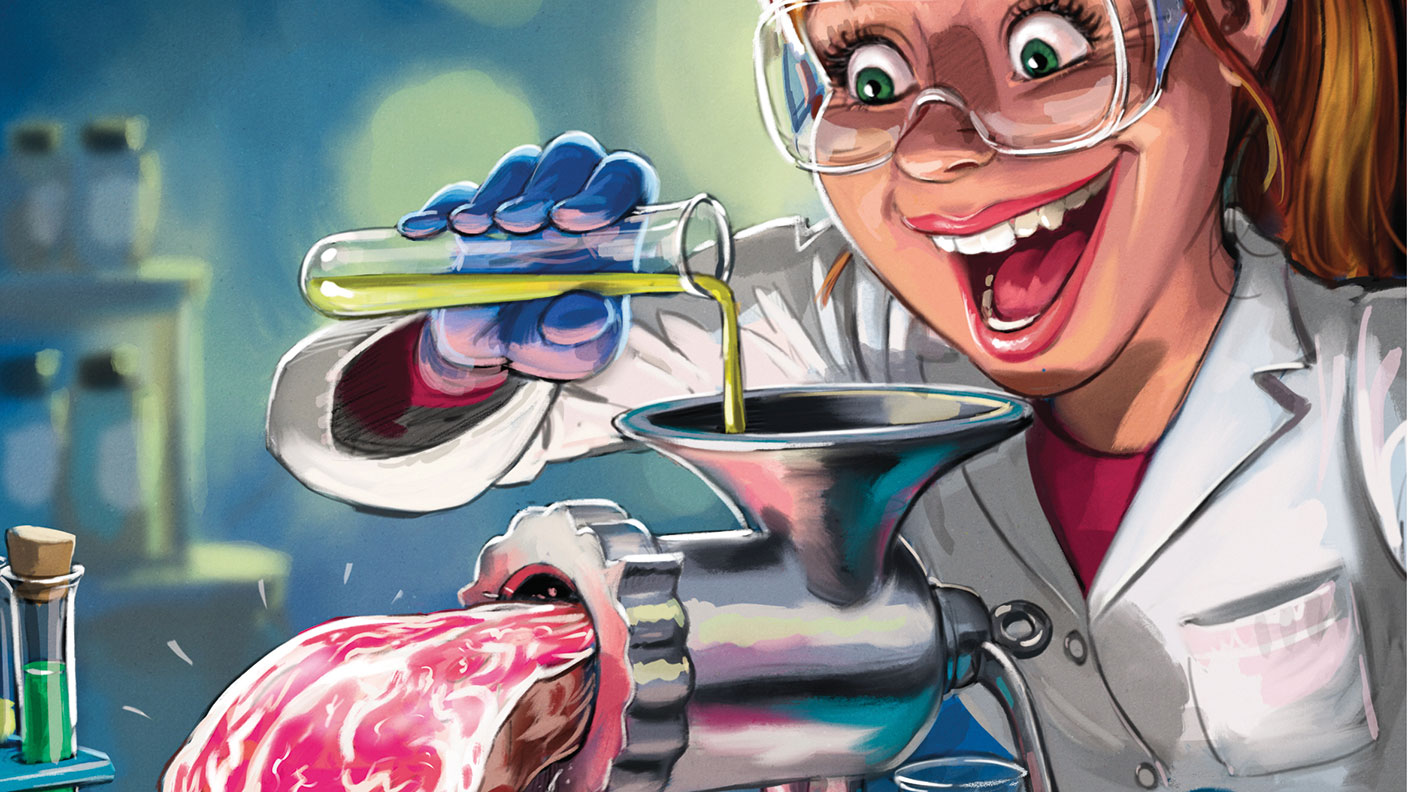How to invest in lab-grown meat – the future of food production
With lab-grown meat, steak is back on the menu for greens and animal lovers – but at what cost? Stuart Watkins reports


The Dish of the Day at the Restaurant at the End of the Universe, as fans of Douglas Adams’ Hitchhiker’s Guide to the Galaxy will know, was a prime cut from the Ameglian Major cow, an artificially created, speaking bovine quadruped, which was bred to actually want to be eaten. The beast unconcernedly offers diners its shoulder braised in white wine sauce. When the animal goes off to shoot itself, it winks at the more squeamish customers, telling them not to worry as “I’ll be very humane”.
Advances in modern technology have got us used to life imitating art. So you will probably not be surprised to hear that today Ameglian Major steaks – or at least, cuts of meat that have involved no cruelty to the animal or harm to the environment, having been cultured from harvested animal cells in a laboratory – are already on the menu. Whether such grub will win broad acceptance by consumers, or profits for investors, however, remains to be seen.
A solution in search of a problem?
You might wonder what the point of growing meat in a laboratory is when nature has been doing it for us since before our expulsion from Eden. If your inclinations or beliefs are against the slaughter of animals, as they are for an increasing number of vegetarians, vegans and “flexitarians”, it’s not as if we have ever been short of other options. Asian Buddhists who eschew flesh have been making mock meat from wheat gluten for more than 1,500 years, as Jon Fasman points out in The Economist. “Milk” made from soy beans has been drunk in China for centuries.
MoneyWeek
Subscribe to MoneyWeek today and get your first six magazine issues absolutely FREE

Sign up to Money Morning
Don't miss the latest investment and personal finances news, market analysis, plus money-saving tips with our free twice-daily newsletter
Don't miss the latest investment and personal finances news, market analysis, plus money-saving tips with our free twice-daily newsletter
Still, the fact is that our modern diets represent historically unprecedented feats of incredible economic and technological complexity. The result, for those of us in the rich world at least, is an abundance of food and a plethora of choice from all the cultures of the world at low prices, but at an increasingly burdensome environmental cost.
As Fasman says, “Such a diet has only become possible in a very particular world, one in which a large proportion of the planet’s surface is given over to farms and pasture, food production is energy-intensive, pesticides abundant, intercontinental shipping cheap and food processing an advanced industrial undertaking. It is only possible, that is to say, at a time when human desires, and the economies built around them, rank among the planet-shaping forces of nature: a period that has come to be known as the Anthropocene.”
The trouble with the Anthropocene economy is that it is fuelled by fossils and burning them is warming the planet dangerously. As no vegan will ever tire of telling you, meat is a big part of that problem, not least because “meat isn’t just about meat”, as Harry de Quetteville puts it in The Daily Telegraph. It’s also about crops –almost half of global production is used to feed livestock; about water – animals consume a third of the planet’s increasingly scarce fresh water that is used in farming; about drugs – the industrial use of antibiotics as animal medicines and growth promoters gives rise to antibiotic-resistant strains of bugs, “accelerating a potential catastrophe that would make Covid-19 look like a sideshow”; about land – meat is the biggest driver of deforestation; about the seas – a third of fish stocks are overexploited; and about the climate – meat is responsible for a disproportionate amount of the greenhouse-gas emissions involved in feeding the planet, which themselves make up almost 40% of the global total. In short, the problem is bad enough as it is – it is only going to get worse as the world’s population grows, and as the poor get richer and start demanding the kind of diets we in the West take for granted.
If all this is the result of our building industrial economies around human desires, then there are two obvious options if the outcome is a problem – deal with our desires, or come up with some kind of technological fix to change the outcome. The zeitgeist is clearly with the latter kind of thinking. “We think of our [food] as a tech product,” the president of Impossible Foods, a plant-based alternative burger maker, told Fasman.
One of the technological challenges is to create plant-based alternatives to meat since growing plants and eating them directly is more energetically efficient than feeding them to livestock first. Another is to create meat in a laboratory without going through the intermediary stage of growing it on a sentient being – this might be more appealing to those who worry about cruelty and be more environmentally friendly, assuming the energy the processes consume is produced sustainably, and the technology can reach the necessary scale. The race is on to become the first Google of the griddle.
A taste for meat
Impossible Foods, like its better-known rival Beyond Meat, spends much of its time in the laboratory figuring out how to make its processed, but entirely plant-based, foods taste more like meat. The present writer can attest that Beyond’s products when cooked fill the house with the right greasy smells and feel much like meat in the mouth. They don’t taste much like meat, nor do they taste like freshly prepared natural food, but then they don’t taste at all bad either. Such processed foods have already found their niche, in the supermarkets and in the fast-food chains, and growth and profits seem likely.
There is, however, no avoiding the fact that a great many people do not want to eat processed pea protein, or not just that, no matter how good its mimicry. They want meat and will want it in increasing numbers as the ranks of the global middle class swell. That’s why some environmentalists, including The Guardian’s George Monbiot, are enthusiastic about the prospects for laboratory-based meat. “It might seem odd for someone who has spent his life calling for political change to enthuse about a technological shift,” Monbiot has written. But the political and other changes that might save the planet need to take place more rapidly than seems likely, he argues. Lab-grown, farm-free food “offers hope where hope was missing”.
Monbiot will presumably be encouraged by the pace of change. Nearly 100 firms are scrambling to be the first to bring cultured meat to market, says Fasman. Those with deep pockets can buy it already in select locations, including a private club in Singapore and a test kitchen in Tel Aviv. The strategy seems to be to follow Tesla – if you want to get customers excited about electric cars, introducing weird-looking, badly performing milk floats isn’t going to get pulses racing; you have to start with the desirable, aspirational models and make your alternative as good as, or better than, the “real” thing.
You will, in other words, probably be able to pay through the nose for a lab-grown steak in a fancy-pants restaurant before you’ll see it on the shelves in Sainsbury’s. True, no cultured-meat company has yet produced anything likely to make diners trade their Porsche-like dining experience for the prototype Teslas currently in development. But great strides are being made. Optimists think it’s only a matter of time before technological barriers are broken (going from animal-cell slurry to something that looks and feels and tastes like a rib of beef is easier said than done and, as in nature, demands the timely and coordinated input of raw materials and energy) and costs come down (prototype chicken nuggets from Just Inc in the US currently cost $50 a pop).
Take some cold water first
Optimism is exactly what you’ll need to fill up on before buying in. A detailed debunking exercise by US news site The Counter pours much cold water on the hype in the industry. Just like self-driving cars, flying taxis, drone deliveries, hydrogen-powered economies and tourist trips to Mars, such exciting technology is always promised to be right around the corner – and perhaps it always will be. The inconvenient truth, says Joe Fassler in The Counter, is that if lab-made meat is to live up to the hype and do anything at all for the climate, a “sequence of as-yet-unforeseen breakthroughs will still be necessary”, including the knowledge of how to train cells to behave in ways not yet accomplished and make bioreactors that “defy widely accepted principles of chemistry and physics”. Cultured cells tend, awkwardly, to be fed by a broth made from slaughtered cows, and replacing that with cost-effective alternatives will be a challenge. Then all this will need to be scaled up. Investors are going to have to “care less about money”, in short. They will also need to be optimistic about the prospects of these products gaining public acceptance and regulatory approval – far from a given.
Still, it takes more than a bucket of cold water to keep the optimists down and it’s not hard to think of examples in the history of the development of new technologies where they have had the last laugh. And there seems to be no shortage of optimists in the food-technology sector. The alternative-protein industry – comprising those made from plants, from cultivation or fermentation – raised $3.1bn in investment in 2020, according to the Good Food Institute, three times more than in any other year in the industry’s history. Cultured meat products are forecast to take a growing slice of the total meat market, eating into perhaps a third or more of the total meat market of $1.8trn by 2040, according to the Meat Atlas report.
The hopefuls with their eyes on that prize are as yet unlisted, venture-capital-backed start-ups, but investors can get in on the action through investment vehicles such as Agronomics (LSE: ANIC), co-founded by Anthony Chow and Jim Mellon. It has a portfolio of 16 leading businesses in the industry, including BlueNalu, which specialises in lab-created seafood, and Mosa Meat, which is aiming to produce a beefburger in the next couple of years. Agronomics trades at a lofty valuation of £221.5m, and there’s no denying the high levels of risk, but the firm is on a strong financial footing and “has the potential to explode over the long term”, says Zaven Boyrazian for Motley Fool. Indeed, Chow and Mellon told MoneyWeek earlier this year that they estimate the total addressable market for the foods, seafood and materials they are investing in to be around $5trn – about twice the size of the UK economy. “You can see why we’re excited about this opportunity.”
An alternative to consider is Canadian-based Eat Beyond Global (Toronto: EATS). MoneyWeek’s David Stevenson runs a news blog on the industry, covering the broader food and agricultural technology sector, at futurefoodfinance.com.
Get the latest financial news, insights and expert analysis from our award-winning MoneyWeek team, to help you understand what really matters when it comes to your finances.

Stuart graduated from the University of Leeds with an honours degree in biochemistry and molecular biology, and from Bath Spa University College with a postgraduate diploma in creative writing.
He started his career in journalism working on newspapers and magazines for the medical profession before joining MoneyWeek shortly after its first issue appeared in November 2000. He has worked for the magazine ever since, and is now the comment editor.
He has long had an interest in political economy and philosophy and writes occasional think pieces on this theme for the magazine, as well as a weekly round up of the best blogs in finance.
His work has appeared in The Lancet and The Idler and in numerous other small-press and online publications.
-
 PayPoint: A promising stock for income-seekers
PayPoint: A promising stock for income-seekersPayPoint, a household name across Britain, is moving away from its traditional roots toward a digital future. Investors after a steady income should buy in
-
 Invest in forestry: a tax-efficient way to grow your wealth
Invest in forestry: a tax-efficient way to grow your wealthRecord sums are pouring into forestry funds. It makes sense to join the rush, says David Prosser
-
 PayPoint: a promising stock for income-seekers
PayPoint: a promising stock for income-seekersPayPoint, a household name across Britain, is moving away from its traditional roots toward a digital future. Investors after a steady income should buy in
-
 Investing in forestry: a tax-efficient way to grow your wealth
Investing in forestry: a tax-efficient way to grow your wealthRecord sums are pouring into forestry funds. It makes sense to join the rush, says David Prosser
-
 The MoneyWeek investment trust portfolio – early 2026 update
The MoneyWeek investment trust portfolio – early 2026 updateThe MoneyWeek investment trust portfolio had a solid year in 2025. Scottish Mortgage and Law Debenture were the star performers, with very different strategies
-
 Pundits had a bad 2025 – here's what it means for investors
Pundits had a bad 2025 – here's what it means for investorsThe pundits came in for many shocks in 2025, says Max King. Here is what they should learn from them
-
 The MoneyWeek ETF portfolio – early 2026 update
The MoneyWeek ETF portfolio – early 2026 updateThe MoneyWeek ETF portfolio had a solid year in 2025 and looks well placed for what the next 12 months may bring
-
 'Investors should brace for Trump’s great inflation'
'Investors should brace for Trump’s great inflation'Opinion Donald Trump's actions against Federal Reserve chair Jerome Powell will likely stoke rising prices. Investors should prepare for the worst, says Matthew Lynn
-
 The state of Iran’s collapsing economy – and why people are protesting
The state of Iran’s collapsing economy – and why people are protestingIran has long been mired in an economic crisis that is part of a wider systemic failure. Do the protests show a way out?
-
 The rise and fall of Nicolás Maduro, Venezuela's ruthless dictator
The rise and fall of Nicolás Maduro, Venezuela's ruthless dictatorNicolás Maduro is known for getting what he wants out of any situation. That might be a challenge now